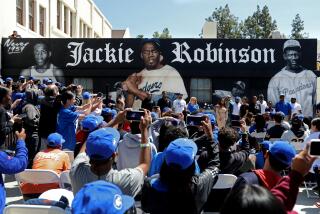World War II Ended and a Sports Boom Began
- Share via
NEW YORK — VE-Day, May 8, 1945, which was followed three months later by VJ-Day, touched off celebrations all over the world--one of which may be said to be still going on in the United States.
For the end of the war marked the beginning of America’s biggest sports boom.
Sports in the United States were not hurt badly by the war. The quality of play diminished as many of the stars entered the armed forces but standards were fairly high.
Glenn Davis and Doc Blanchard helped to make Army the undisputed No. 1 college football team in the nation in 1944 and 1945. Border-line major leaguers performed on many teams but the St. Louis Cardinals’ starting lineup in the sixth and decisive game of the 1944 World Series included stars like Stan Musial, Walker Cooper, Ray Sanders, Whitey Kurowski and Marty Marion.
Maurice Richard, a star in any era, scored a record 50 goals in the 50-game 1944-45 National Hockey League season and thoroughbred racing had a Triple Crown winner in Count Fleet in 1943.
The end of World War I brought the United States its first sports boom, spurred on by the growth of radio. Other countries saw the United States as a country at play on a scale greater than any other in history. The boom after World War II was bigger--in fact, is still continuing--because it was fueled by television and air travel.
With the end of World War II, events in sports moved with bewildering speed.
In 1946, Jackie Robinson became the first acknowledged black man in organized baseball when he signed a Montreal contract and in 1947 the first to play in the major leagues when he joined the Brooklyn Dodgers.
The National Basketball Association was founded in 1946 with teams in Washington, Philadelphia, New York, Providence, Toronto, Boston, Chicago, St. Louis, Cleveland, Detroit and Pittsburgh.
The All America Conference was founded in 1946 as a rival to the National Football League. Paul Brown introduced his Cleveland Browns, led by quarterback Otto Graham and featuring black stars in fullback Marion Motley and guard Bill Willis, and set in motion pressures that led NFL expansion to its current size.
The National Hockey League increased its schedule from 50 to 60 games in the 1946-47 season and began to visualize its growth from its traditional six teams.
Thanks at least in part to training methods developed during World War II, players 6-foot-6 or more became more common on college basketball teams and the search for today’s seven-footers was on in earnest.
In 1946, too, came the long-awaited second bout between heavyweight champion Joe Louis and Billy Conn, who had almost upset Louis in 1941. It was a keen disappointment, both fighters having lost their talents during the war. Louis won on an eight-round knockout but made only three more title defenses before passing into history.
The “gray era” of Ezzard Charles and Joe Walcott followed before Rocky Marciano won the crown in 1952 and restored the heavyweight title to the stature it had known during Louis’ triumphant years.
More to Read
Go beyond the scoreboard
Get the latest on L.A.'s teams in the daily Sports Report newsletter.
You may occasionally receive promotional content from the Los Angeles Times.










